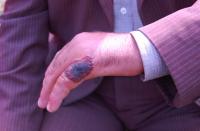Anthrax Cases in Humans and Animals – Akre district, Duhok
Report No. 1
From: Dr. Abdullah Saeed Abdullah
Director General of Health; Duhok
To: MoH KRG-Erbil, MoH Baghdad, MoA KRG-Erbil WHO Iraq, UNICEF Iraq, DoH Erbil
Thirty-seven cutanous anthrax cases reported in humans in three villages; MIMBARI, CHAMSINI, GOHANI of Dentarta sub-district; Akre district. These reports coincident with reported anthrax cases and deaths in animals (cattle, and cows).
On 29th September 2008, the directorate of Health in Akre informed by the Animal Health section; about deaths in animals (livestock) in above-mentioned villages due to laboratory (DUHOK Veterinary Lab) confirmed Anthrax.
On 1st October; a team composed of Health sector director, an Internist, District surveillance officer and a bacteriologist visited the affected villages to find, investigate and manage the cases in humans and to take smears from them.
The team met the community leaders, and people in these villages and discussed the control measures including early reporting of cases in animals, humans and the measures to be taken in management of carcasses of dead animals; distribution of health messages through religious leaders.
The team was and still in communication with the District Mayor, the General Directorate of Health (GDOH) in Duhok, and The General Directorate of Veterinary in Duhok.
On 4th October, a team composed of CDC manger, a dermatologist from the GDOH Duhok and Akre Health sector director accompanied by local authority staff visited the most affected village; MIMBARI for further investigation and management of the cases.
Total of 17 cutaneous anthrax cases diagnosed on clinical and epidemiologically linked to cases in animals, in above village and further; 7 cases from CHAMSINI, 4 from GOHANI and 2 cases from BAMSHMISH villages were identified.
An orientation session for the villagers organized in two villages about the control of the disease and preventive measures; antibiotics treatment distributed to the cases and contacts and to the risky groups. The team recommended to distribute personal protection equipment by the health sector to risky groups and to ensure proper burring procedures of carcasses.
The veterinary teams were applied control measures since the beginning of the reporting of anthrax in Animals; started by managing the cases by antibiotics and currently implementing vaccination campaign to all animals in the affected area and its surrounding.
Forty cases out of the 40 resided the above-mentioned villages and other seven cases are visited the affected areas during the same period of infection. All the cases were cutaneous lesions on their hands and arms giving the clinical picture of cutaneous anthrax and all of them had history of contact with affected animals through either slaughtering or preparing or handling the meat of affected animals. Nineteen (51%) cases were males; 31 (84%) were more than 15-years of age.
Smears from lesions of affected cases examined in District lab and were negatives for anthrax; these smears will be double-checked by the provincial lab in Duhok.
In 2007, there were three cases of cutaneous anthrax in Zakho district.






